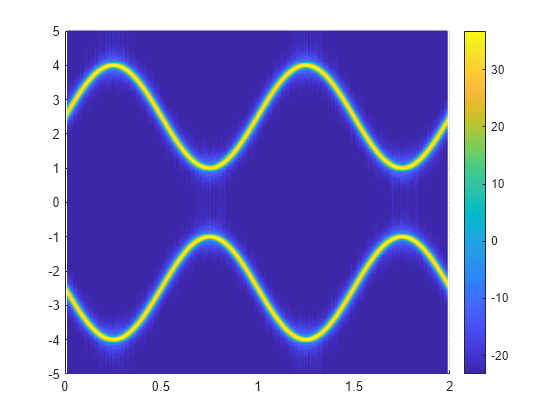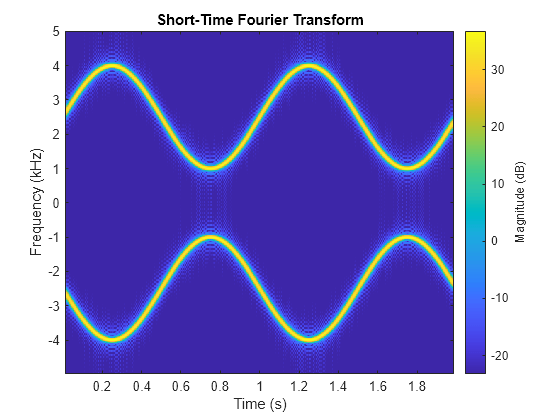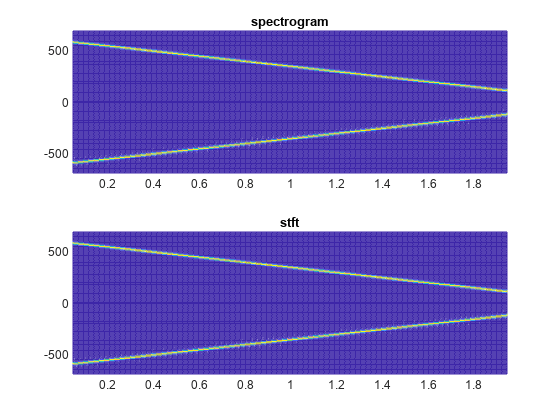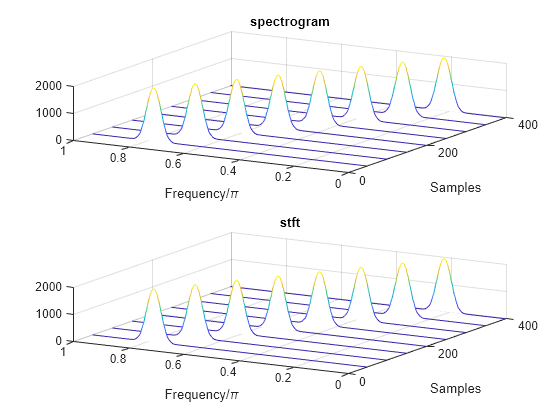stft
短时傅里叶变换
语法
说明
s = stft(___,Name=Value)
不带输出参量的 stft(___) 在当前图窗窗口中以分贝为单位绘制 STFT 的幅值平方。
示例
生成频率呈正弦变化的啁啾。信号以 10 kHz 频率进行 2 秒采样。
fs = 10e3; t = 0:1/fs:2; x = vco(sin(2*pi*t),[0.1 0.4]*fs,fs);
计算啁啾的短时傅里叶变换。将信号分成长度为 256 个采样的段,并使用形状参数 β = 5 的凯塞窗对每个段加窗。指定相邻段之间有 220 个采样的重叠,并指定 DFT 长度为 512。输出在其上计算 STFT 的频率和时间值。
[s,f,t] = stft(x,fs,Window=kaiser(256,5),OverlapLength=220,FFTLength=512);
STFT 的幅值平方也称为频谱图。以分贝为单位绘制频谱图。指定一个跨 60 dB 的颜色图,其最后颜色对应频谱图的最大值。
sdb = mag2db(abs(s)); mesh(t,f/1000,sdb); cc = max(sdb(:))+[-60 0]; ax = gca; ax.CLim = cc; view(2) colorbar

通过调用不带输出参量的 stft 函数获得相同的图。
stft(x,fs,Window=kaiser(256,5),OverlapLength=220,FFTLength=512)

生成以 1 kHz 进行 2 秒采样的二次啁啾。瞬时频率在 处为 100 Hz,并在 秒处超出 200 Hz。
ts = 0:1/1e3:2; f0 = 100; f1 = 200; x = chirp(ts,f0,1,f1,"quadratic",[],"concave");
计算并显示持续 1 毫秒的二次啁啾的 STFT。
d = seconds(1e-3);
win = hamming(100,"periodic");
stft(x,d,Window=win,OverlapLength=98,FFTLength=128);
生成一个由在 1.4 kHz 下采样 2 秒的啁啾组成的信号。在测量时间内,啁啾的频率从 600 Hz 线性增加到 100 Hz。
fs = 1400; x = chirp(0:1/fs:2,600,2,100);
stft 默认值
使用 spectrogram 和 stft 函数计算信号的 STFT。使用 stft 函数的默认值:
将信号分成若干长度为 128 个采样的段,并使用周期性汉宁窗对每个段加窗。
指定相邻段之间有 96 个采样的重叠。此长度等效于窗长度的 75%。
指定 128 个 DFT 点并将 STFT 中心设在零频率处,频率以赫兹为单位表示。
验证两个结果是否相等。
M = 128; g = hann(M,"periodic"); L = 0.75*M; Ndft = 128; [sp,fp,tp] = spectrogram(x,g,L,Ndft,fs,"centered"); [s,f,t] = stft(x,fs); dff = max(max(abs(sp-s)))
dff = 0
使用 mesh 函数绘制两个输出。
nexttile mesh(tp,fp,abs(sp).^2) title("spectrogram") view(2), axis tight nexttile mesh(t,f,abs(s).^2) title("stft") view(2), axis tight

spectrogram 默认值
使用 spectrogram 函数的默认值重复计算:
将信号分成长度为 的段,其中 是信号的长度。使用汉明窗对每个段加窗。
指定段之间有 50% 的重叠。
为了计算 FFT,请使用 个点。仅计算正归一化频率的频谱图。
M = floor(length(x)/4.5); g = hamming(M); L = floor(M/2); Ndft = max(256,2^nextpow2(M)); [sx,fx,tx] = spectrogram(x); [st,ft,tt] = stft(x,Window=g,OverlapLength=L, ... FFTLength=Ndft,FrequencyRange="onesided"); dff = max(max(sx-st))
dff = 0
使用 waterplot 函数绘制两个输出。在这两种情况下都将频率轴除以 。对于 stft 输出,将采样数除以有效采样率 。
figure nexttile waterplot(sx,fx/pi,tx) title("spectrogram") nexttile waterplot(st,ft/pi,tt/(2*pi)) title("stft")

function waterplot(s,f,t) % Waterfall plot of spectrogram waterfall(f,t,abs(s)'.^2) set(gca,XDir="reverse",View=[30 50]) xlabel("Frequency/\pi") ylabel("Samples") end
生成一个信号,其采样率为 5 kHz,采样时间持续 4 秒。信号由一组持续时间递减的脉冲组成,各脉冲由振幅振荡和频率波动且呈递增趋势的区域分隔。绘制信号。
fs = 5000; t = 0:1/fs:4-1/fs; x = besselj(0,600*(sin(2*pi*(t+1).^3/30).^5)); plot(t,x)

计算信号的单边、双边和居中短时傅里叶变换。在所有情况下,使用形状因子为 的长度为 202 个采样的凯塞窗对信号段加窗。显示用于计算每个变换的频率范围。
rngs = ["onesided" "twosided" "centered"]; for kj = 1:length(rngs) opts = {'Window',kaiser(202,10),'FrequencyRange',rngs(kj)}; [~,f] = stft(x,fs,opts{:}); subplot(length(rngs),1,kj) stft(x,fs,opts{:}) title(sprintf('''%s'': [%5.3f, %5.3f] kHz',rngs(kj),[f(1) f(end)]/1000)) end
![Figure contains 3 axes objects. Axes object 1 with title 'onesided': [0.000, 2.500] kHz, xlabel Time (s), ylabel Frequency (kHz) contains an object of type image. Axes object 2 with title 'twosided': [0.000, 4.975] kHz, xlabel Time (s), ylabel Frequency (kHz) contains an object of type image. Axes object 3 with title 'centered': [-2.475, 2.500] kHz, xlabel Time (s), ylabel Frequency (kHz) contains an object of type image.](../../examples/signal/win64/STFTFrequencyRangesExample_02.png)
重复计算,但现在将凯塞窗的长度更改为奇数 203。'twosided' 频率区间不变。其他两个频率区间在高端变为开放。
for kj = 1:length(rngs) opts = {'Window',kaiser(203,10),'FrequencyRange',rngs(kj)}; [~,f] = stft(x,fs,opts{:}); subplot(length(rngs),1,kj) stft(x,fs,opts{:}) title(sprintf('''%s'': [%5.3f, %5.3f] kHz',rngs(kj),[f(1) f(end)]/1000)) end
![Figure contains 3 axes objects. Axes object 1 with title 'onesided': [0.000, 2.488] kHz, xlabel Time (s), ylabel Frequency (kHz) contains an object of type image. Axes object 2 with title 'twosided': [0.000, 4.975] kHz, xlabel Time (s), ylabel Frequency (kHz) contains an object of type image. Axes object 3 with title 'centered': [-2.488, 2.488] kHz, xlabel Time (s), ylabel Frequency (kHz) contains an object of type image.](../../examples/signal/win64/STFTFrequencyRangesExample_03.png)
生成一个三通道信号,该信号由在 1 kHz 下采样一秒的三个不同啁啾组成。
第一个通道由凹二次啁啾组成,瞬时频率在 t = 0 处为 100 Hz,在 t = 1 秒处超出 300 Hz。其初始相位等于 45 度。
第二个通道由凸二次啁啾组成,瞬时频率在 t = 0 处为 100 Hz,在 t = 1 秒处超出 500 Hz。
第三个通道由对数啁啾组成,瞬时频率在 t = 0 处为 300 Hz,在 t = 1 秒处超出 500 Hz。
使用长度为 128 的周期性汉明窗和 50 个采样的重叠长度计算多通道信号的 STFT。
fs = 1e3; t = 0:1/fs:1-1/fs; x = [chirp(t,100,1,300,'quadratic',45,'concave'); chirp(t,100,1,500,'quadratic',[],'convex'); chirp(t,300,1,500,'logarithmic')]'; [S,F,T] = stft(x,fs,'Window',hamming(128,'periodic'),'OverlapLength',50);
将每个通道的 STFT 可视化为瀑布图。使用辅助函数 helperGraphicsOpt 控制坐标区的行为。
waterfall(F,T,abs(S(:,:,1))') helperGraphicsOpt(1)

waterfall(F,T,abs(S(:,:,2))') helperGraphicsOpt(2)

waterfall(F,T,abs(S(:,:,3))') helperGraphicsOpt(3)

此辅助函数设置当前坐标区的外观和行为。
function helperGraphicsOpt(ChannelId) ax = gca; ax.XDir = 'reverse'; ax.ZLim = [0 30]; ax.Title.String = ['Input Channel: ' num2str(ChannelId)]; ax.XLabel.String = 'Frequency (Hz)'; ax.YLabel.String = 'Time (seconds)'; ax.View = [30 45]; end
输入参数
输入信号,指定为向量、矩阵或 MATLAB® timetable。
注意
如果您需要 x 和 s 长度相同,则 (length( 的值必须为整数。使用 x)-noverlap)/(length(window)-noverlap)Window 指定 window 的长度,使用 OverlapLength 指定 noverlap。
如果输入有多个通道,请将
x指定为矩阵,其中每列对应一个通道。对于时间表输入,
x必须包含均匀递增的有限行时间。如果时间表有缺失或重复的时间点,您可以使用清理包含缺失、重复或不均匀时间的时间表中的提示进行修复。对于多通道时间表输入,将
x指定为具有单个变量(其中包含一个矩阵)的时间表,或指定为具有多个变量(其中每个变量包含一个列向量)的时间表。所有变量必须具有相同的精度。
x 的每个通道的长度必须大于或等于窗长度。
示例: chirp(0:1/4e3:2,250,1,500,"quadratic") 指定一个单通道啁啾。
示例: timetable(rand(5,2),SampleRate=1) 指定一个在 1 Hz 下采样 4 秒的双通道随机变量。
示例: timetable(rand(5,1),rand(5,1),SampleRate=1) 指定一个在 1 Hz 下采样 4 秒的双通道随机变量。
数据类型: double | single
复数支持: 是
采样率,指定为正标量。此参量仅当 x 是向量或矩阵时适用。
数据类型: double | single
名称-值参数
将可选参量对组指定为 Name1=Value1,...,NameN=ValueN,其中 Name 是参量名称,Value 是对应的值。名称-值参量必须出现在其他参量之后,但对各个参量对组的顺序没有要求。
示例: Window=hamming(100),OverlapLength=50,FFTLength=128 使用长度为 100 个采样的汉明窗对数据加窗,相邻段之间有 50 个采样的重叠且 FFT 包含 128 个点。
如果使用的是 R2021a 之前的版本,请使用逗号分隔每个名称和值,并用引号将 Name 引起来。
示例: 'Window',hamming(100),'OverlapLength',50,'FFTLength',128 使用长度为 100 个采样的汉明窗对数据加窗,相邻段之间有 50 个采样的重叠且 FFT 包含 128 个点。
频谱窗,指定为向量。如果您未指定窗或将其指定为空,则函数使用长度为 128 的汉宁窗。Window 的长度必须大于或等于 2。
有关可用窗的列表,请参阅加窗法。
示例: hann(N+1) 和 (1-cos(2*pi*(0:N)'/N))/2 都指定长度为 N + 1 的汉宁窗。
数据类型: double | single
重叠采样的数量,指定为小于 Window 长度的正整数。如果您省略 OverlapLength 或将其指定为空,则它设置为小于窗长度的 75% 的最大整数,对于默认汉宁窗为 96 个采样。
数据类型: double | single
DFT 点数,指定为正整数。该值必须大于或等于窗长度。如果输入信号的长度小于 DFT 长度,则数据用零填充。
数据类型: double | single
STFT 频率范围,指定为 "centered"、"twosided" 或 "onesided"。
"centered"- 计算一个双边、居中 STFT。如果FFTLength是偶数,则s在区间 (–π, π] 弧度/采样点上计算。如果FFTLength是奇数,则s在区间 (–π, π) 弧度/采样点上计算。如果您指定时间信息,则区间分别为 (–fs, fs/2] 周期/单位时间和 (–fs, fs/2) 周期/单位时间,其中 fs 是有效采样率。"twosided"- 在区间 [0, 2π) 弧度/采样点上计算双边 STFT。如果您指定时间信息,则区间为 [0, fs) 周期/单位时间。"onesided"- 计算单边 STFT。如果FFTLength是偶数,则s在区间 [0, π] 弧度/采样点上计算。如果FFTLength是奇数,则s在区间 [0, π) 弧度/采样点上计算。如果您指定时间信息,则区间分别为 [0, fs/2] 周期/单位时间和 [0, fs/2) 周期/单位时间,其中 fs 是有效采样率。此选项仅对实信号有效。注意
当此参量设置为
"onesided"时,stft输出正奈奎斯特范围内的值,并且不保持总功率。
有关示例,请参阅STFT 频率范围。
数据类型: char | string
输出时间维度,指定为 "acrosscolumns" 或 "downrows"。如果希望将 s 的时间维度沿行排列,频率维度沿列排列,请将此值设置为 "downrows"。如果希望将 s 的时间维度沿列排列,频率维度沿行排列,请将此值设置为 "acrosscolumns"。如果不带输出参量调用该函数,则忽略此输入。
输出参量
短时傅里叶变换,以矩阵或三维数组形式返回。时间按 s 的列从左到右递增,频率按行从上到下递增。第三个维度(如果存在)对应一个输入通道。
如果信号
x有 Nx 个时间采样,则s有 k 列,其中 k = ⌊(Nx–L)/(M–L)⌋,M 是Window的长度,L 是OverlapLength,⌊ ⌋ 符号表示向下取整函数。s中的行数等于在FFTLength中指定的值。
数据类型: double | single
在其上计算 STFT 的频率,以向量形式返回。
数据类型: double | single
详细信息
短时傅里叶变换 (STFT) 用于分析非平稳信号的频率成分随时间变化的情况。STFT 的幅值平方称为信号的频谱图时频表示。有关频谱图以及如何使用 Signal Processing Toolbox™ 函数计算频谱图的详细信息,请参阅Spectrogram Computation with Signal Processing Toolbox。
信号的 STFT 是通过将长度为 M 的分析窗 g(n) 滑过信号并计算每段加窗数据的离散傅里叶变换 (DFT) 来计算的。窗以 R 个采样的间隔跳过原始信号,等效于相邻段之间有 L = M – R 个采样的叠加。大多数窗函数在边缘处逐渐变细以避免频谱振铃。每个加窗段的 DFT 会添加到复数值矩阵中,该矩阵包含每个时间点和频率点处的幅值和相位。STFT 矩阵有
列,其中 Nx 是信号 x(n) 的长度,⌊⌋ 符号表示向下取整函数。对于居中和双边变换,矩阵中的行数等于 NDFT(DFT 点数);对于实数值信号的单边变换,则等于接近 NDFT/2 的奇数。
STFT 矩阵 的第 m 列包含以时间 mR 为中心的加窗数据的 DFT:
参考
[1] Mitra, Sanjit K. Digital Signal Processing: A Computer-Based Approach. 2nd Ed. New York: McGraw-Hill, 2001.
[2] Sharpe, Bruce. Invertibility of Overlap-Add Processing. https://gauss256.github.io/blog/cola.html, accessed July 2019.
[3] Smith, Julius Orion. Spectral Audio Signal Processing. https://ccrma.stanford.edu/~jos/sasp/, online book, 2011 edition, accessed Nov 2018.
扩展功能
C/C++ 代码生成
使用 MATLAB® Coder™ 生成 C 代码和 C++ 代码。
用法说明和限制:
代码生成不支持时间表。
此函数完全支持 GPU 数组。有关详细信息,请参阅在 GPU 上运行 MATLAB 函数 (Parallel Computing Toolbox)。
版本历史记录
在 R2019a 中推出
MATLAB Command
You clicked a link that corresponds to this MATLAB command:
Run the command by entering it in the MATLAB Command Window. Web browsers do not support MATLAB commands.
选择网站
选择网站以获取翻译的可用内容,以及查看当地活动和优惠。根据您的位置,我们建议您选择:。
您也可以从以下列表中选择网站:
如何获得最佳网站性能
选择中国网站(中文或英文)以获得最佳网站性能。其他 MathWorks 国家/地区网站并未针对您所在位置的访问进行优化。
美洲
- América Latina (Español)
- Canada (English)
- United States (English)
欧洲
- Belgium (English)
- Denmark (English)
- Deutschland (Deutsch)
- España (Español)
- Finland (English)
- France (Français)
- Ireland (English)
- Italia (Italiano)
- Luxembourg (English)
- Netherlands (English)
- Norway (English)
- Österreich (Deutsch)
- Portugal (English)
- Sweden (English)
- Switzerland
- United Kingdom (English)